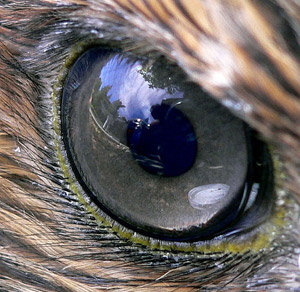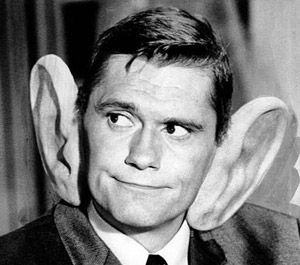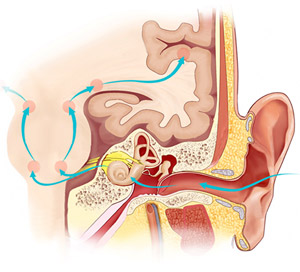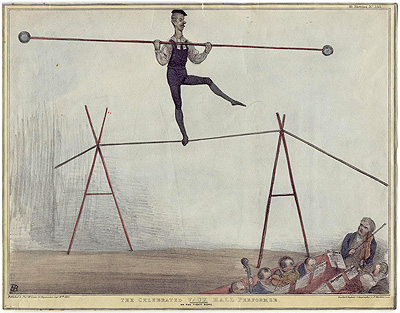The Human Senses and Sense Organs
We all know we have 5 senses - or do we?
You probably learned when you were quite small that we have five senses, the ones in the pictures at the top of this page. However this is not exactly true, things are not as clear as they seem and we are sensitive to other things as well.
Our senses work by responding to stimuli from the outside world. A sense organ detects the stimulus and converts it into a nervous impulse that transmits information about the size and/or nature of the stimulus to our brain. Our brain then interprets the nervous impulse and makes us aware of the stimulus in an appropriate way.
The idea of five senses can be traced back to the Greek philosopher Aristotle 384-322 BC and like many old ideas it is sufficiently satisfying and "intuitive" to have persisted for the over two thousand years since.
 Alexander: "How many senses do you
reckon
Alexander: "How many senses do you
reckonwe've got then Aristotle?"
Aristotle: <waves arm> "about 5"
Sight / vision
 The
most obvious of the senses, the one we are most aware of and
the pre-dominant sense in humans that our brains are designed
to understand and process, dogs predominantly sense the world
through smell for instance, whereas we sense it mainly through
sight.
The
most obvious of the senses, the one we are most aware of and
the pre-dominant sense in humans that our brains are designed
to understand and process, dogs predominantly sense the world
through smell for instance, whereas we sense it mainly through
sight.
Our sense organ for sight is of course the eye. We have two ways of seeing though they are very closely bound together and we use them seamlessly and sometimes together. We have very detailed colour vision that works in bright light and a much less detailed black and white vision that works in very dim light. The colour vision uses cells in our eyes called cones which are sensitive to red, green or blue light (approximately, there is some overlap), between them they are able to make up all the other colours in a similar manner to how a monitor or tv screen has red, blue and green dots that make all colours. You have around 5 million cone cells in each eye concentrated into an area about 0.3mm in diameter called the fovea centralis or yellow spot.
In addition to cones, we also have rod cells in our eyes. The rods are much more numerous with about 125 million in your retina, though they are more spread out rather than being concentrated in one area like the cones. Rods are far more sensitive to light than cones, about a hundred times more. In normal daylight they are all desensitized and so ignored by the brain. When the light falls however, the rods can start to detect light when the cones have become all but useless. Though rods enable vision in lower light conditions, that vision has low resolution and little detail and is slower to react than the vision given by cones meaning fast moving scenes are more difficult to follow.
Having two eyes pointing in the same direction but slightly apart gives us stereoscopic vision and so the ability to gauge distance. Each eye sends a slightly different image to our brain which combines the two into a single image but in "3D". While we might think of our eyes as acting like a camera on the outside world, there is an awful lot of processing that goes on by the brain too to help us make sense of what we see and especially to decide what is and isn't so important. Optical illusions take advantage of this processing by the brain to fool us into seeing things in ways that don't always make sense.

The edges of the green shapes all line up straight, processing by our eyes and brain trying to be helpful in an unusual situation results in the optical illusion

A graphic showing how molecules (blue, left) can be detected by one or more chemical receptors, red indicates a fit
Hearing
 HearingOur
sense of hearing is a response to sound waves generated in the
air or less frequently through solid media such as the ground
(or occasionally and annoyingly through your pillow when you're
trying to sleep). All animals that can hear have a particular
auditory range of frequencies that they can can detect. In man
this range goes from about 20 Hz (Hz - Hertz = cycles or vibrations
per second) to about 20,000 Hz, 20 being a very low booming
bass and 20,000 a very, very high pitched sound. We are
most sensitive to sounds at around 1,000 Hz (1 kHz) which correspond
with the human voice. As we get older, the upper value starts
to fall and we are less able to hear very high pitched sounds.
HearingOur
sense of hearing is a response to sound waves generated in the
air or less frequently through solid media such as the ground
(or occasionally and annoyingly through your pillow when you're
trying to sleep). All animals that can hear have a particular
auditory range of frequencies that they can can detect. In man
this range goes from about 20 Hz (Hz - Hertz = cycles or vibrations
per second) to about 20,000 Hz, 20 being a very low booming
bass and 20,000 a very, very high pitched sound. We are
most sensitive to sounds at around 1,000 Hz (1 kHz) which correspond
with the human voice. As we get older, the upper value starts
to fall and we are less able to hear very high pitched sounds.
The sense organs for earing are our ears which are split into outer, middle and inner ears. The outer ear captures the sound and funnels it down the auditory canal to the ear-drum. The ear drum is made to vibrate by sound waves, the vibrations are passed on through the three smallest bones in the human body which are in the inner ear which amplify these sound waves, though also have tiny muscles attached to them to protect us from very loud sounds. They are most active when we are talking, shouting, or singing ourselves. Just before we speak and especially just before we speak loudly, those little muscles contract to make sure we don't deafen ourselves, so the old teachers saying of "you can't talk and listen at the same time" is true I'm afraid. Your ear switches off to some degree when you start to talk. The now amplified vibrations pass into the inner ear, buried inside your skull where they move a fluid inside the cochlea which is shaped like a coiled snails shell, it is like this to get a long thing into a smaller space. The cochlea contains thousands of tiny hair-like structures (nothing like the hair on your head however) which move with the sound and turn this movement into a nerve impulse which goes to your brain.
Two ears allow for being able to decide which direction a stimulus is coming from and make wearing glasses far easier. The inner ear also contains balance sense organs, more of these later.

The path taken by vibrations and nerve impulses leading to hearing

Texas blind salamander - if a sense is not able to be used as is the case for these cave-dwelling amphibians that live in total darkness, then other senses become more heightened to compensate.
Taste
What happens when you eat something or put it in your mouth, gustation to use another unnecessarily odd word. What we think of as happening when we eat something isn't just about taste but also largely about smell at the same time. I'm sure you've had a cold and found you can't really taste food very well. It's nothing to do with the taste buds on your tongue, but to do with losing your sense of smell so diminishing the overall sensation that results from the information your taste buds and your nose send to your brain before putting them together to tell you what you can "taste", mmm... olives or gorgonzola, or yuck - a greasy burger for instance.
Smell
Olfaction, another chemical sense like taste, that this time detects air-borne rather than dissolved chemicals. The nose is the olfactory organ or receptor. Many, as many as 350 different receptors identify particular parts of molecules. An individual molecule can stimulate different receptors in different ways, so leading to thousands of different smells being identified. The sense of smell is closely related to the sense of taste, dissolved chemicals in food or drink in the mouth can evaporate and so stimulate olfactory receptors . As with vision, processing by the brain has a significant part to play in the detection of smells and in the information recovered from this detection, humans have a relatively small part of the brain dedicated to processing smells and so it is a relatively unimportant sense compared to animals such as dogs and moles.

Touch
Mechanoreception, the detection of physical stimuli by a range of receptors in the skin. The receptors are quite similar in their structure though are placed at different depths in the skin, they are found all over the skin though vary in their density. The hands have the highest concentration of touch receptors, followed by the lips and tongue. The different receptors are similar in their structure but are wired differently to the brain so those that are situated more deeply are perceived as a more intense touch and pressure, the shallower receptors are perceived as a more delicate touch. Hairs on the skin also have their own touch receptors so movements of the hairs can be detected.
Other Senses
"Other senses?" what could be meant by this? Common sense? Spidey sense? The ability to detect a drop of blood in the water a mile away like sharks can ('t)? Aristotle's five senses are a rather simplistic way of interpreting the way that human detect the world around them. There isn't really a specifically settled number of senses as such, though neuroscientists consider that we have anywhere between 9 and 21, maybe more. It's partly a case of how you count them which in turn is based on which sensors are involved.
Vision - this could be seen as one sense or two, one that detects colours and rapid movement in high definition in bright light and the other that detects very low levels of light in black and white but with less detail and less response to rapid movements.
Hearing - not only via the ears, we can detect vibrations through any part of our body. This can be especially pronounced in some deaf people who can detect vibrations through the feet when standing as "sound" even though their ears are not functional.
Taste and Smell - some people think each of the five tastes could be thought of as a sense on its own, you also don't really get taste without smell as well.
Touch - This can be split into several components, touch as we know it but also sensitivity to temperature (thermoception), pain (nociception) which is regarded as separate from ordinary touch, pressure and itching which is something different altogether.
Balance or equilibrioception - thanks to those three semi-circular canals in your inner ear that are full of movable fluid and sensory hairs that are moved when the fluid moves. These tell you which way your head and body is tilted in relation to gravity and give you information about movements and acceleration. They are also incidentally responsible for sea-sickness when the brain is fed conflicting information about the world from your ears and your eyes, the reason why you should get off your bed and go on deck to look at the horizon so the information matches.
Proprioception - the sense of knowing where you body parts are in relation to each other. Close your eyes and touch your nose, move your hand away or closer, at all times you are aware of exactly where your hand is even though you can't see it. Likewise, you can reach down and touch your leg, knee, ankle, foot etc. without looking first.
Time or temporal perception - not universally accepted this one, though it seems that our sense of the passage of time is located in specific parts of the brain. Without external sensory clues (such as daylight) people settle in a daily routine, even though it's not always 24 hours.
Internal senses
Unlike those mentioned so far, these are not senses that are directly involved in the way we detect or interact with the outside world, they don't give us information of the world outside of our body, but of the world inside our body, our body may or may not choose to inform us what is going on, more often than not it responds without consultation.
Chemical receptors - in the brain that respond to rising carbon dioxide levels in the blood to increase breathing depth and rate, and also to detect chemicals that may cause us to vomit. Other receptors determine how concentrated the blood is and so cause excess water to be taken out into the bladder by the kidneys or create a feeling of thirst so we top up again with water.
Stretch receptors - in various places that tell you about gas distention in your intestines (a good trump always makes you feel better), you need to pee when your bladder wall is stretched by accumulating urine, and to contract your top thigh muscle to prevent pulled muscle damage in the knee-jerk reflex.
Tension receptors - found throughout your muscles so allowing your brain to co-ordinate movement and posture based on feedback about the state of the muscle.
Photo credits:
Big eye: Petr Novak,
Wikipedia Creative commons C2.5 license
Section through skull:
By Patrick J. Lynch, medical illustrator (Patrick J. Lynch,
medical illustrator) Creative commons C2.5 license
Bird eye:
Steve Jurvetson Creative commons C2.0 license







